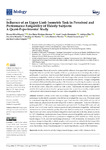Mostrar o rexistro simple do ítem
Influence of an Upper Limb Isometric Task in Perceived and Performance Fatigability of Elderly Subjects: A Quasi-Experimental Study
| dc.contributor.author | Gómez Salgado, Juan | |
| dc.contributor.author | Silva-Migueis, Helena | |
| dc.contributor.author | Martínez-Jiménez, Eva María | |
| dc.contributor.author | Casado-Hernández, Israel | |
| dc.contributor.author | Dias, Adriano | |
| dc.contributor.author | Martins, Rodrigo B. | |
| dc.contributor.author | Monteiro, Ana Júlia | |
| dc.contributor.author | Romero Morales, Carlos | |
| dc.contributor.author | López-López, Daniel | |
| dc.date.accessioned | 2023-02-07T07:55:34Z | |
| dc.date.available | 2023-02-07T07:55:34Z | |
| dc.date.issued | 2022-08 | |
| dc.identifier.citation | Silva-Migueis, H.; Martínez-Jiménez, E.M.; Casado-Hernández, I.; Dias, A.; Monteiro, A.J.; Martins, R.B.; Romero-Morales, C.; López-López, D.; Gómez-Salgado, J. Influence of an Upper Limb Isometric Task in Perceived and Performance Fatigability of Elderly Subjects: A Quasi-Experimental Study. Biology 2022, 11, 1175. https://doi.org/10.3390/biology11081175 | es_ES |
| dc.identifier.uri | http://hdl.handle.net/2183/32437 | |
| dc.description.abstract | [Abstract] Isometric activity can be used as a strategy to improve health, fitness, and functional performance in the elderly population, but differences in fatigability may occur. This study aimed to understand fatigability behavior during an upper limb isometric task (ULIT) and the role of health status and physical activity in the fatigability of elderly participants. Thirty-two (32) elderly participants (72.5 ± 5.18 years) were instructed to perform ULIT. The Borg CR10 scale and task failure point (TTF) were used to measure perceived and performance fatigability. Self-reported measures were used to assess the quality of life and physical activity level. A significant relationship between perceived and performance fatigability was found only in the final phase of activity (p < 0.01). Significant correlations were found between perceived fatigability and the social functioning dimension (p < 0.05), and between performance fatigability (TTF) and BMI (p < 0.01), physical functioning (p < 0.01), and role functioning/physical (p < 0.05) dimensions. In conclusion, ULIT produces changes in fatigability of elderly people, which are positively related in the final stage of the activity. Changes in fatigability are negatively related to BMI. It is also negatively related to health, social functioning, physical functioning and role functioning/physical quality of life dimensions. | es_ES |
| dc.language.iso | eng | es_ES |
| dc.publisher | MDPI | es_ES |
| dc.relation.uri | https://doi.org/10.3390/biology11081175 | es_ES |
| dc.rights | Atribución 3.0 España | es_ES |
| dc.rights.uri | http://creativecommons.org/licenses/by/3.0/es/ | * |
| dc.subject | Elderly | es_ES |
| dc.subject | Isometric activity | es_ES |
| dc.subject | Fatigue | es_ES |
| dc.subject | Muscle fatigue | es_ES |
| dc.subject | Quality of life | es_ES |
| dc.subject | Physical activity | es_ES |
| dc.subject | Actividad física | es_ES |
| dc.subject | Ancianos | es_ES |
| dc.subject | Actividad isométrica | es_ES |
| dc.subject | Fatiga | es_ES |
| dc.subject | Fatiga muscular | es_ES |
| dc.subject | Calidad de vida | es_ES |
| dc.title | Influence of an Upper Limb Isometric Task in Perceived and Performance Fatigability of Elderly Subjects: A Quasi-Experimental Study | es_ES |
| dc.type | info:eu-repo/semantics/article | es_ES |
| dc.rights.access | info:eu-repo/semantics/openAccess | es_ES |
| UDC.journalTitle | Biology | es_ES |
| UDC.volume | 11 | es_ES |
| UDC.issue | 8 | es_ES |
| UDC.startPage | 1175 | es_ES |
Ficheiros no ítem
Este ítem aparece na(s) seguinte(s) colección(s)
-
GI-UDISAP - Artigos [194]






